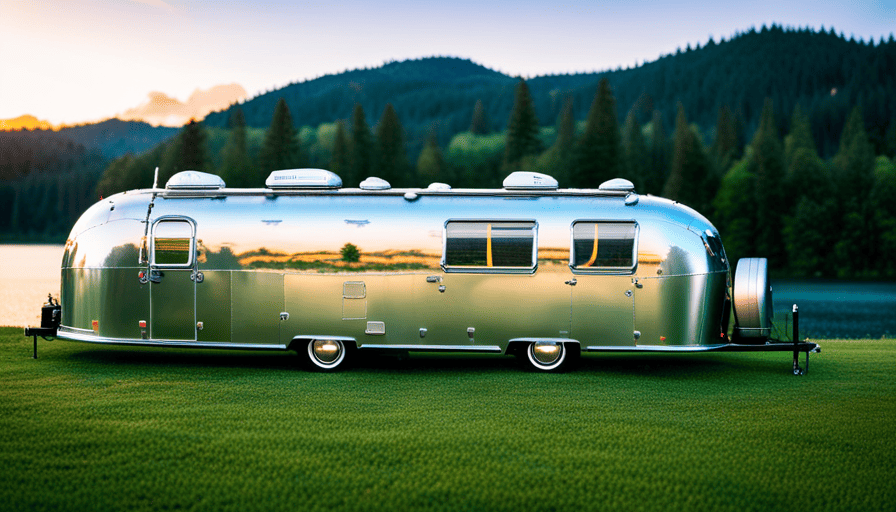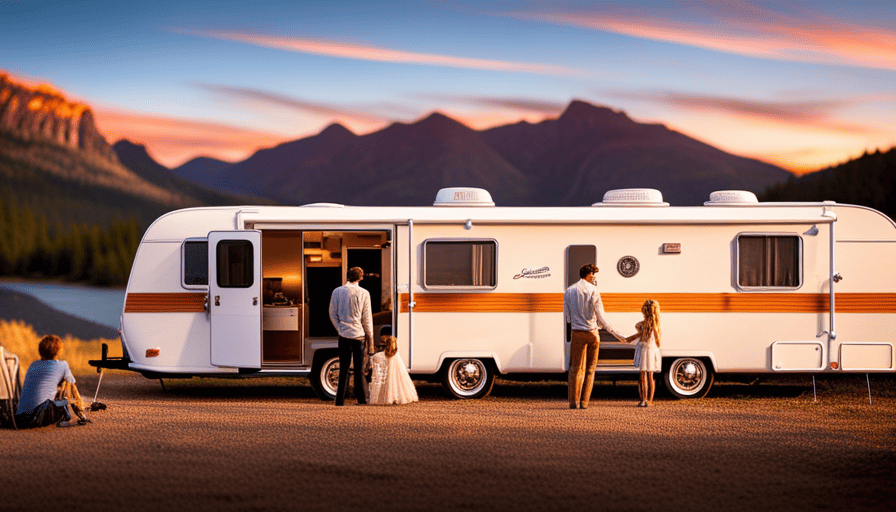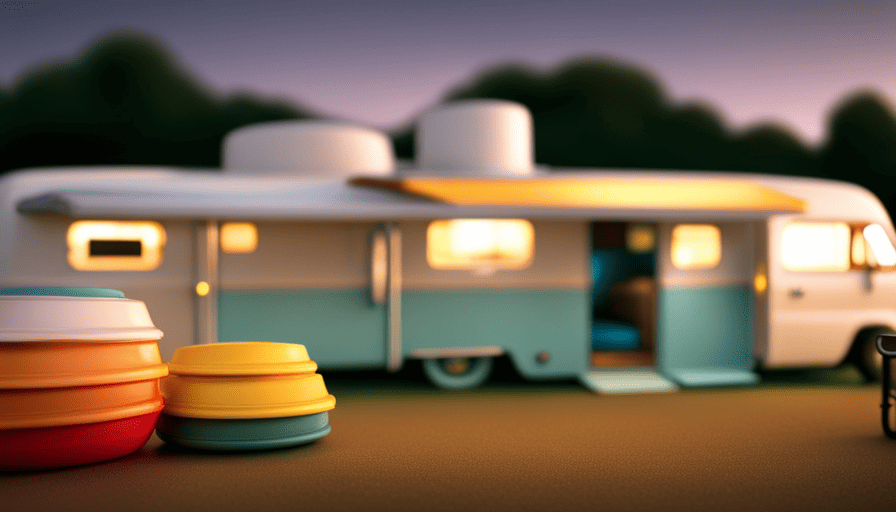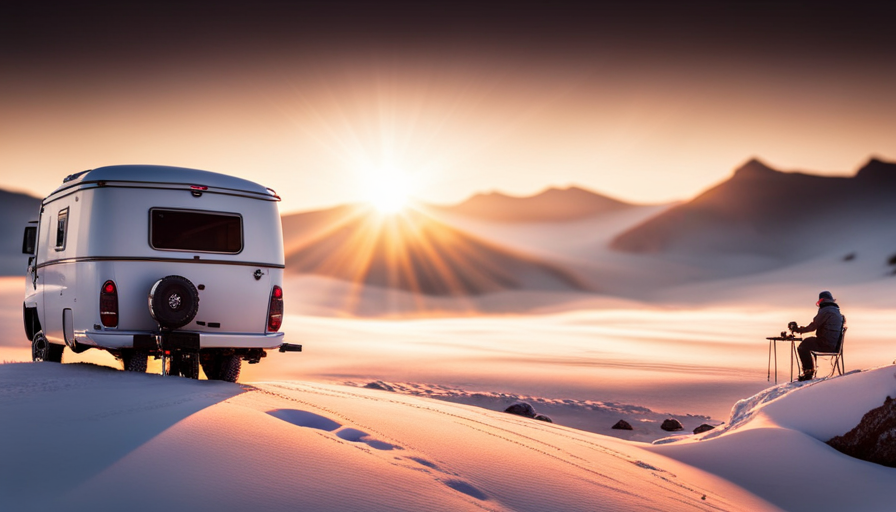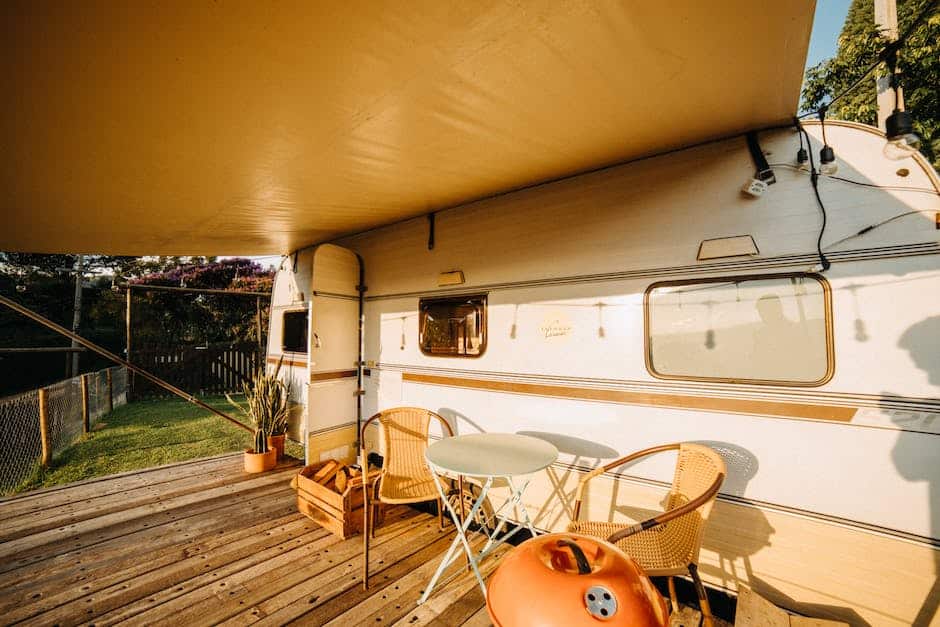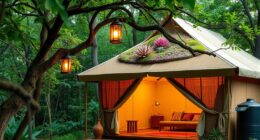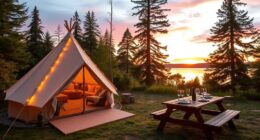Have you ever dreamed of traveling the roads in style and luxury? Look no further, the iconic Airstream trailer is your answer. These sleek aluminum campers have symbolized a spirit of adventure and wanderlust for decades.
But before you start planning your cross-country road trip, you’re probably wondering, ‘How much is an Airstream camper?’
Let me tell you, these beauties don’t come cheap. Depending on the type and condition, Airstream campers can range anywhere from $30,000 to over $150,000. But don’t let the price tag scare you off just yet. There are various factors that affect the cost, such as size, features, and age. And if a brand new Airstream is out of your budget, don’t worry. There are plenty of used options available that can save you some serious cash.
In this article, we’ll dive into the different types of Airstream campers, the factors that affect their price, and whether buying new or used is the better option for you. We’ll also explore additional costs to consider, negotiating and financing options, and even delve into the world of DIY Airstream renovations.
So, buckle up and get ready to discover everything you need to know about owning an Airstream and embracing the nomadic lifestyle.
Key Takeaways
- Airstream campers range in price from $30,000 to over $150,000.
- Factors influencing the cost of an Airstream camper include size, features, and age.
- Used Airstream campers are available at lower prices.
- Popular Airstream models include the Bambi, Flying Cloud, International Serenity, and Classic.
Types of Airstream Campers
There’s a wide range of Airstream campers available, catering to different preferences and budgets. When it comes to types of Airstream models, there are several options to choose from.
The most popular Airstream models include the Bambi, Flying Cloud, International Serenity, and Classic. Each model offers its own unique features and floorplans to suit various camping needs.
The Bambi is the smallest and most lightweight Airstream, perfect for those who prioritize maneuverability and ease of towing. The Flying Cloud is a versatile model with multiple floorplans, offering a range of sleeping arrangements and amenities. The International Serenity is designed for those seeking a modern and tranquil camping experience, with its sleek interior and calming color palette. The Classic is the largest Airstream model, providing ample space and luxury features for a comfortable camping experience.
These popular Airstream floorplans come in different lengths and layouts, ensuring that there’s a camper to fit every camping style and family size. From compact and cozy to spacious and luxurious, Airstream offers a camper for everyone.
Now, let’s move on to the factors that affect the price of an Airstream camper, so you can make an informed decision about your purchase.
Factors that Affect the Price
When determining the price of an Airstream camper, there are several factors that come into play.
First, the size and layout of the camper can greatly affect its price. Larger campers with more spacious layouts typically come at a higher cost.
Additionally, the age and condition of the camper will also impact its price. Older campers or those in need of repairs may be priced lower than newer, well-maintained ones.
Lastly, the features and amenities included in the camper can also affect its price. Campers with high-end features and luxurious amenities will generally have a higher price tag.
Size and layout
You can imagine the spaciousness and design of different sizes and layouts of an Airstream camper. The size of an Airstream camper can range from 16 to 33 feet in length, and the layout can vary depending on the model. To give you a better idea, take a look at the table below:
| Size (feet) | Layout |
|---|---|
| 16 | Compact and cozy, ideal for solo travelers or couples |
| 19 | Comfortable for a small family or a few friends |
| 23 | Offers more living space and amenities |
| 26 | Suitable for larger families with additional sleeping options |
| 33 | Spacious and luxurious, perfect for extended travel or full-time living |
As you can see, the size and layout of an Airstream camper play a significant role in determining its price. Now, let’s move on to the next section and discuss how the age and condition of the camper can affect its cost.
Age and condition
To really understand the impact on cost, imagine stepping inside a vintage Airstream with its worn upholstery and retro charm. Age and condition are important pricing factors when it comes to Airstream campers.
Older models that have been well-maintained and restored can still fetch a high price due to their nostalgic appeal and rarity. On the other hand, if an Airstream is in poor condition or has not been properly cared for, it can significantly decrease its value. Factors such as leaks, rust, and structural damage can all affect the cost of an Airstream. Additionally, the overall condition of the interior, including appliances and fixtures, can also impact the price.
When considering the purchase of an Airstream camper, it’s important to thoroughly inspect and assess its age and condition to ensure you are getting a fair price. Moving on to the next section about ‘features and amenities,’ it’s also essential to consider the interior offerings of an Airstream.
Features and amenities
The interior offerings of an Airstream are essential to consider when evaluating its overall value and desirability. Airstream campers are known for their sleek and modern design, as well as their high-quality craftsmanship. The features and amenities that come with an Airstream can vary depending on the model and year. However, there are some popular amenities that many Airstreams offer. These include a fully equipped kitchen with a stove, refrigerator, and sink, a comfortable sleeping area with a cozy bed, a bathroom with a toilet and shower, and plenty of storage space for all your camping gear. It’s important to note that the more features and amenities an Airstream has, the higher the price will typically be. Speaking of price, let’s now delve into the topic of new vs. used Airstreams.
New vs. Used Airstreams
Looking to score a killer deal? Snagging a used Airstream camper will make you feel like you’ve hit the jackpot! When it comes to choosing between new and used Airstreams, there are several factors that can affect the price. Here are four key things to consider:
-
Age: The age of the Airstream plays a significant role in determining its price. Generally, older models will be more affordable compared to newer ones.
-
Condition: The overall condition of the camper is crucial. A well-maintained used Airstream with minimal wear and tear will likely come with a higher price tag than one that requires extensive repairs.
-
Upgrades and Modifications: If the previous owner has made any upgrades or modifications, such as adding solar panels or renovating the interior, it can significantly impact the price. These additions can enhance the camper’s value and convenience.
-
Rarity: Certain Airstream models or editions may be harder to find, making them more valuable on the used market. Limited editions or vintage models can fetch a higher price due to their uniqueness and desirability.
Considering these factors, you can find a wide range of prices for used Airstream campers. Transitioning into the next section about the average price range, there are several steps you can take to determine the right price for your dream Airstream camper.
Average Price Range
When it comes to purchasing an Airstream camper, there are three main price ranges to consider: entry-level, mid-range, and high-end.
Entry-level Airstreams typically range from $40,000 to $60,000 and offer basic amenities and features.
Mid-range Airstreams, on the other hand, fall within the $60,000 to $90,000 price range and come with more advanced features and options.
Finally, high-end Airstreams can cost upwards of $90,000 and offer luxurious finishes, top-of-the-line appliances, and customizations.
Entry-level Airstreams
Interested in getting your hands on an entry-level Airstream camper? Well, you’re in luck! Entry-level Airstreams are a great way to start your RVing adventures without breaking the bank.
When it comes to entry-level Airstream prices, you can expect to find models ranging from around $40,000 to $60,000, depending on the specific features and floorplans you choose.
Some of the best entry-level Airstream models include the Sport and the Flying Cloud. These models offer a perfect combination of affordability and quality, with stylish interiors and all the essential amenities you need for a comfortable camping experience.
Now, let’s move on to the next section and explore the world of mid-range Airstreams.
Mid-range Airstreams
Moving up from the entry-level Airstreams, let’s take a look at the mid-range Airstream camper models. These models offer more features and upgrades compared to the entry-level ones, making them a popular choice among camping enthusiasts.
One popular mid-range Airstream model is the Flying Cloud, known for its contemporary design and spacious interiors. It offers a variety of floor plans to suit different needs and preferences.
Another model worth considering is the International Serenity, which focuses on creating a tranquil and relaxing living space with its soothing color palette and high-end finishes.
Lastly, the Globetrotter is a stylish and modern option, designed for those who seek a sleek and sophisticated camping experience.
When it comes to upgrades, mid-range Airstreams often feature amenities like solar panels, larger tanks for extended off-grid camping, and advanced technology for seamless connectivity. These upgrades enhance the overall camping experience and make the mid-range Airstreams a popular choice for those seeking a balance between luxury and affordability.
Next, let’s explore the high-end Airstreams and discover the ultimate in luxury travel.
High-end Airstreams
Feeling like you deserve the pinnacle of opulence and extravagance? Look no further than the high-end Airstreams, where luxury and indulgence know no bounds. These high-end Airstream models are the epitome of sophistication, offering a range of lavish features and amenities that will make you feel like you’re staying in a five-star hotel on wheels.
From state-of-the-art entertainment systems and plush leather interiors to gourmet kitchens and spacious master suites, these luxury Airstreams have it all. You can expect top-of-the-line appliances, high-end finishes, and cutting-edge technology throughout. Every detail has been carefully considered to provide the ultimate in comfort and style.
However, as with any luxury purchase, there are additional costs to consider. Moving on to the next section about ‘additional costs to consider’, let’s explore the financial aspects of owning a high-end Airstream.
Additional Costs to Consider
When buying an Airstream camper, it’s important to take into account the additional costs involved. While the price of the camper itself can vary depending on the model and features, there are other expenses that should be considered to ensure a thorough budgeting process. These additional costs, or hidden expenses, can include insurance, maintenance, and storage fees.
To give you a better idea of what to expect, here is a breakdown of some common additional costs associated with owning an Airstream camper:
| Additional Cost | Estimated Expense |
|---|---|
| Insurance | $500 – $1,500 per year |
| Maintenance | $500 – $1,000 per year |
| Storage fees | $50 – $200 per month |
Insurance is vital to protect your investment and can vary depending on factors such as the value of the camper and your location. Maintenance costs can include regular servicing, repairs, and upgrades to keep your Airstream in top condition. Storage fees may be necessary if you don’t have space to park the camper at home.
Taking these additional costs into consideration will help you budget more accurately when purchasing an Airstream camper. Now that you have an understanding of the expenses involved, let’s explore where to find Airstream campers for sale.
Where to Find Airstream Campers for Sale
To locate Airstream campers available for purchase, you can explore various online marketplaces and dealership websites. There are several places where you can find used Airstream campers for sale. One popular online marketplace is eBay, where you can find a wide selection of Airstream campers in different models and conditions.
Another option is Craigslist, which allows you to search for Airstream campers in your local area. Additionally, you can check out websites dedicated to RV sales, such as RV Trader and RVUSA, where you can find both new and used Airstream campers.
When buying a used Airstream camper, it’s important to negotiate the price to ensure you’re getting the best deal possible. Start by doing research on the average price range for the specific model you’re interested in. This will give you a better understanding of what a fair price should be.
When negotiating, be prepared to walk away if the price is not within your budget. You can also consider financing options to make the purchase more affordable.
Moving forward, let’s discuss negotiating and financing options for buying an Airstream camper.
Negotiating and Financing Options
When it comes to buying an Airstream camper, finding the right one is just the first step. Once you’ve found the perfect Airstream for your needs, it’s time to negotiate a price and explore your financing options.
Negotiating strategies can vary depending on the seller, but it’s always important to do your research and come prepared. Start by determining the fair market value of the camper based on its condition, age, and any additional features it may have. This will give you a good starting point for negotiations. Don’t be afraid to negotiate the price, as sellers are often willing to lower their asking price to make a sale.
Additionally, don’t forget to explore financing options. Many buyers choose to finance their Airstream camper through a bank or credit union, while others may opt for dealer financing. Be sure to compare interest rates and loan terms to find the best option for your budget.
With these negotiating and financing strategies in mind, you’ll be well-prepared to make the purchase of your dream Airstream camper. Now, let’s dive into the next step of your Airstream adventure: DIY Airstream renovation.
DIY Airstream Renovation
When it comes to renovating a used Airstream, there are both pros and cons to consider.
On the positive side, renovating allows you to customize the space to fit your specific needs and style. However, it can also be a time-consuming and expensive process.
To help make your renovation more budget-friendly, I’ll share some tips and tricks to save money without sacrificing quality. Additionally, I’ll provide you with resources and inspiration for DIY projects to help you create the Airstream of your dreams.
Pros and cons of renovating a used Airstream
Renovating a used Airstream is like breathing new life into a vintage symphony, blending nostalgia with modern comforts. When considering a DIY renovation, it’s important to be aware of the challenges you may face.
First, you’ll need to assess the condition of the Airstream and determine the extent of repairs needed. Next, estimating renovation costs can be tricky as unforeseen issues may arise during the process. It’s crucial to have a detailed budget in place to avoid overspending.
Additionally, sourcing materials and finding skilled labor can be time-consuming and expensive. However, the rewards of renovating a used Airstream are plentiful. You’ll have the opportunity to create a personalized space that reflects your style and preferences.
As we delve into budget-friendly renovation tips, you’ll discover how to make the most of your project without breaking the bank.
Budget-friendly renovation tips
Revamping an old Airstream on a tight budget is like transforming a blank canvas into a vibrant masterpiece. With some budget-friendly design ideas and eco-friendly renovation options, you can give your Airstream a fresh new look without breaking the bank.
One great way to save money is by opting for upcycled materials, such as reclaimed wood for flooring or repurposed furniture for storage. Another budget-friendly option is to focus on cosmetic changes, like painting the cabinets or updating the curtains and upholstery.
For an eco-friendly touch, consider using low VOC paints and sustainable materials. Additionally, incorporating energy-efficient appliances and LED lighting can help reduce your carbon footprint and save money in the long run.
With these budget-friendly and eco-friendly renovation tips, you can transform your Airstream into a stylish and sustainable home on wheels. Looking for resources and inspiration for DIY projects? Stay tuned for the next section.
Resources and inspiration for DIY projects
After learning some budget-friendly renovation tips for an Airstream camper, I’m now excited to explore resources and find inspiration for DIY projects. Converting a standard van into a DIY camper van can be a fun and rewarding project for those who enjoy hands-on work.
There are numerous online resources available that provide step-by-step guides, helpful tips, and even video tutorials to assist with the conversion process. From layout design to electrical and plumbing installations, these resources offer valuable insights and techniques to ensure a successful project.
Additionally, there are online communities and forums where fellow DIY enthusiasts share their experiences, ideas, and recommendations. By incorporating these DIY camper van conversion tips, you can create a personalized and functional space that meets your needs.
Now, let’s delve into some maintenance and care tips to keep your Airstream camper in top shape.
Maintenance and Care Tips
To keep your airstream camper in top shape, you’ll need to regularly inspect and maintain its various components, just like you would take care of a well-oiled machine. Maintenance tips are crucial to ensure that your airstream remains in optimal condition for years to come.
One important aspect of maintenance is to regularly inspect the exterior for any signs of damage or wear, such as leaks, dents, or loose panels. Addressing these issues promptly can prevent further damage and costly repairs.
Additionally, it’s essential to check the tires and brakes regularly, as they’re critical for safe travels. Maintaining the electrical and plumbing systems is also important, as they can be prone to issues such as faulty wiring or leaks.
Regularly cleaning the interior and exterior of your airstream is another key aspect of maintenance, as it helps prevent dirt and debris from causing damage over time.
By following these maintenance tips and addressing common repairs promptly, you can ensure that your airstream camper remains in excellent condition.
Transitioning to the subsequent section about owning an airstream, it’s important to note that proper maintenance is just one of the many benefits and lifestyle aspects of this iconic camper.
Owning an Airstream: Benefits and Lifestyle
After learning about the essential maintenance and care tips for an Airstream camper, let’s now delve into the benefits and lifestyle of owning one. As an Airstream owner myself, I can confidently say that it’s a lifestyle like no other. The popularity of Airstream campers has skyrocketed in recent years, and it’s not hard to see why.
These iconic silver bullet trailers have had a profound impact on the travel industry, capturing the hearts of adventure seekers and travel enthusiasts worldwide. Here are four reasons why owning an Airstream is an experience in itself:
-
Timeless Design: The distinct silver exterior and sleek curves of an Airstream are instantly recognizable and evoke a sense of nostalgia and classic Americana.
-
Durability and Quality: Airstreams are built to last. Their sturdy construction and high-quality materials ensure that they can withstand the test of time and provide a comfortable living space for years to come.
-
Community and Camaraderie: Airstream owners form a tight-knit community, always eager to share their love for these campers. From organized rallies to impromptu meetups at campsites, the Airstream community offers a sense of belonging and friendship.
-
Freedom to Explore: With an Airstream, the world becomes your backyard. These campers allow you to embark on endless adventures, discovering new places and creating memories along the way.
The popularity of Airstream campers has not only revolutionized the way we travel but has also become a symbol of a lifestyle full of freedom, adventure, and camaraderie.
Frequently Asked Questions
What are some common maintenance and care tips for owning an Airstream camper?
Maintenance and care tips for owning an Airstream camper include regularly cleaning the exterior to prevent dirt and grime buildup. It is also important to inspect and maintain the tires for proper inflation and wear. Additionally, checking and cleaning the awning, and ensuring the propane system is functioning properly is crucial. Regularly inspecting the plumbing system, including the water heater and tanks, is important as well. Lastly, keeping up with routine maintenance tasks like lubricating hinges and locks will help keep your Airstream in top shape.
What are the benefits and lifestyle considerations of owning an Airstream?
Owning an Airstream is like having your own luxurious mobile palace on wheels! The benefits are endless – from the freedom to travel anywhere, anytime, to the unmatched comfort and style that comes with it.
You’ll experience the thrill of exploring new places while having all the amenities of home. However, it’s important to consider the lifestyle aspects too. Living in a compact space requires organization and adaptability, but the sense of community and adventure make it all worthwhile.
Are there any additional costs to consider when purchasing an Airstream camper?
When purchasing an Airstream camper, it’s important to consider the hidden costs that come along with it. These can include maintenance and repairs, as well as campground fees and storage costs.
Additionally, it’s crucial to factor in insurance coverage for your Airstream. This will protect your investment and provide peace of mind while on the road. It’s wise to research different insurance options and choose the one that best suits your needs and budget.
Where can I find Airstream campers for sale?
You can find Airstream campers for sale at Airstream camper dealerships and on various online platforms. Airstream camper dealerships specialize in selling new and used Airstream campers and can provide you with expert guidance and assistance in finding the perfect camper for your needs.
Online platforms such as RV trader, eBay, and Craigslist also offer a wide selection of Airstream campers for sale, allowing you to browse and compare options from the comfort of your own home.
What are some negotiating and financing options available for purchasing an Airstream camper?
When it comes to purchasing an Airstream camper, there are a variety of negotiating techniques and financing options available to make the process smoother.
To negotiate effectively, it’s important to do your research, set a budget, and be prepared to walk away if needed.
As for financing, you can explore options like bank loans, RV financing companies, or even leasing. Each option has its own pros and cons, so it’s essential to weigh them carefully before making a decision.
Conclusion
In conclusion, owning an Airstream is like having your own personal oasis on wheels. These campers are a dream come true for adventure seekers and travel enthusiasts, with their iconic design and luxurious features. The price may vary depending on factors such as size, age, and condition, but the average range for an Airstream camper is well worth the investment. So why wait? Take the leap and embrace the freedom and excitement that comes with owning an Airstream. Get ready to hit the open road and create memories that’ll last a lifetime.

